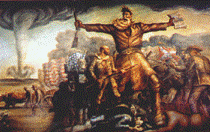History, Department of

James A. Rawley Graduate Conference in the Humanities
Date of this Version
April 2008
Document Type
Article
Abstract
In his History of North Dakota, Elwyn B. Robinson described six themes of North Dakota’s history: remoteness, dependence, radicalism, a position of economic disadvantage, the Too-Much Mistake, and adjustment. Robinson also concluded that these six themes of the state’s history influenced the state’s people and produced the North Dakota character, which included such traits as pride, stubbornness, and radicalism. Robinson’s scholarship did much to illuminate the complexities and interconnectedness of the state’s history, geography, and society, and his History of North Dakota is considered to be the cornerstone of North Dakota historical discourse. But given changes in approaches and interpretation in years since the original 1966 publication, are Robinson’s conclusions still applicable? How did the events and experiences of North Dakotans create a unique sense of community?
This paper will answer these questions by exploring how Robinson’s ideas continue to provide valuable insight into the North Dakota character. In addition, this paper will analyze how the events, issues, and factors within North Dakota’s history created a community of individuals who seek to prosper economically, socially, and politically in a challenging environment.


Comments
Paper presented at the 3rd Annual James A. Rawley Conference in the Humanities — Imagining Communities: People, Places, Meanings. Lincoln, Nebraska, April 12, 2008. Sponsored by the University of Nebraska–Lincoln History Graduate Students’ Association. Copyright © 2008 Jennifer Hath.